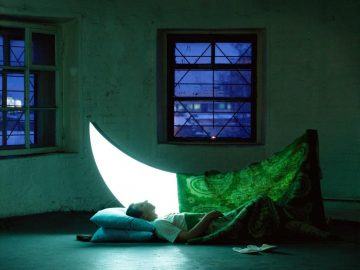Alex Colville in 1843 Magazine:
 Gazing at the Moon is an eternal human activity, one of the few things uniting caveman, king and commuter. Each has found something different in that lambent face. For Li Po, a lonely Tang dynasty poet, the Moon was a much-needed drinking buddy. For Holly Golightly, who serenaded it during the “Moon River” scene of “Breakfast at Tiffany’s”, it was a “huckleberry friend” who could whisk her away from her fire escape and her sorrows. By pretending to control a well-timed lunar eclipe, Columbus recruited it to terrify Native Americans into submission. Mussolini superstitiously feared sleeping in its light, and hid from it behind tightly drawn blinds. It would be a challenge for any museum to chronicle the long, complicated relationship humanity has with the Moon, but the National Maritime Museum in Greenwich, London has done it. For the 50th anniversary of the Apollo 11 Moon landing, the museum has placed relics from those nine remarkable days in July 1969 alongside cuneiform tablets, Ottoman pocket lunar-calendars, giant Victorian telescopes and instruments designed for India’s first lunar probe in 2008. This impressive exhibition tells the history of humanity’s fascination with this celestial body and looks to the future, as humans attempt once again to return to the Moon.
Gazing at the Moon is an eternal human activity, one of the few things uniting caveman, king and commuter. Each has found something different in that lambent face. For Li Po, a lonely Tang dynasty poet, the Moon was a much-needed drinking buddy. For Holly Golightly, who serenaded it during the “Moon River” scene of “Breakfast at Tiffany’s”, it was a “huckleberry friend” who could whisk her away from her fire escape and her sorrows. By pretending to control a well-timed lunar eclipe, Columbus recruited it to terrify Native Americans into submission. Mussolini superstitiously feared sleeping in its light, and hid from it behind tightly drawn blinds. It would be a challenge for any museum to chronicle the long, complicated relationship humanity has with the Moon, but the National Maritime Museum in Greenwich, London has done it. For the 50th anniversary of the Apollo 11 Moon landing, the museum has placed relics from those nine remarkable days in July 1969 alongside cuneiform tablets, Ottoman pocket lunar-calendars, giant Victorian telescopes and instruments designed for India’s first lunar probe in 2008. This impressive exhibition tells the history of humanity’s fascination with this celestial body and looks to the future, as humans attempt once again to return to the Moon.
The Moon was once the domain of the gods, who had placed this seemingly smooth orb in the heavens, the finishing touch to a perfectly ordered creation. The red of the blood Moon was a sign of divine imbalance that only humanity could correct: the Chinese banged mirrors, the Inca shouted and the Romans frantically waved burning torches.
More here.
